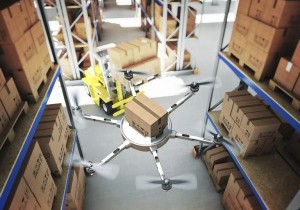Disruptive Technology
Predictions about the future of logistics often include scenarios of driverless trucks loaded with goods cruising effortlessly down the highway and flying drones departing from warehouses to make last-mile deliveries of consumer goods. Will such visions become a reality? Despite anticipated benefits to automated driving and delivery systems, technological, legislative and other barriers could slow their adoption.
Assisted not autonomous
Google earned major media attention last year with its introduction of a prototype self-driving electric car. But in reality, this idea is not new to the supply chain. Autonomous vehicles have been used in material handling applications for years. And multiple vehicle manufacturers, logistics companies and research centers are currently testing the feasibility of putting autonomous vehicles on the road.
Last summer, Daimler AG gave a highway demonstration of its driverless tractor trailer, FutureTruck 2025, which navigates via sensor and camera technology. Daimler plans to have the truck on the road within a decade. A group of Dutch logistics and technology companies has a shorter timetable, however. Within five years it wants to employ driverless trucks to deliver goods from the Port of Rotterdam to other cities in the Netherlands.
Meanwhile, Volvo Trucks has been participating in the SARTRE (Safe Road Trains for the Environment) project to test vehicle platooning. In this system, a driver at the head of a convoy of electronically-linked trucks drives the entire line of vehicles, assisted by automated systems in each vehicle that adjust for following distances and speed. The drivers in the following vehicles serve primarily as emergency backups.
Volvo’s goal is to assist drivers with technology rather than replace them, said Carl-Johan Almqvist, traffic and product safety director at Volvo Truck in Sweden. “We still believe in the human being. We think the driver is extremely good at observing and looking at what’s going on. But at the same time we know that inattention can be a problem for drivers and that they can also misjudge a situation.”
Almqvist expects truly driverless trucks will first appear in restricted areas like ports and terminals, but it will be some time before the technology is road-ready. The cameras, GPS and other systems used by autonomous vehicles rely on a far-from-perfect infrastructure; covered or faded road markings, tunnels and similar obstacles could prevent the system from functioning properly.
DHL Trend Research’s recent report on Self-Driving Vehicles in Logistics also noted the increasing use of autonomous vehicles to move materials around plants and distribution centers, in yards and around ports. Beyond that, Markus Kueckelhaus, director of DHL Trend Research, sees autonomous trucks or delivery vans moving first to highways with limited speeds rather than to busy urban streets with heavy pedestrian and vehicle traffic. “The situations where we have low speeds and where we can immediately control the trucks or the vehicles—those are also the situations where we see autonomous logistics of self-driving trucks to be appropriate in the future,” he said.
“If we’re talking about applications like last-mile delivery of parcels from one household to the next, where you have a delivery system that can run at low speed, those are the solutions that we see feasible in the near future,” Kueckelhaus added. “When we’re talking about public streets with very complex context situations, we are a bit skeptical of seeing solutions within the next five years.”
Click here to read the full article.





